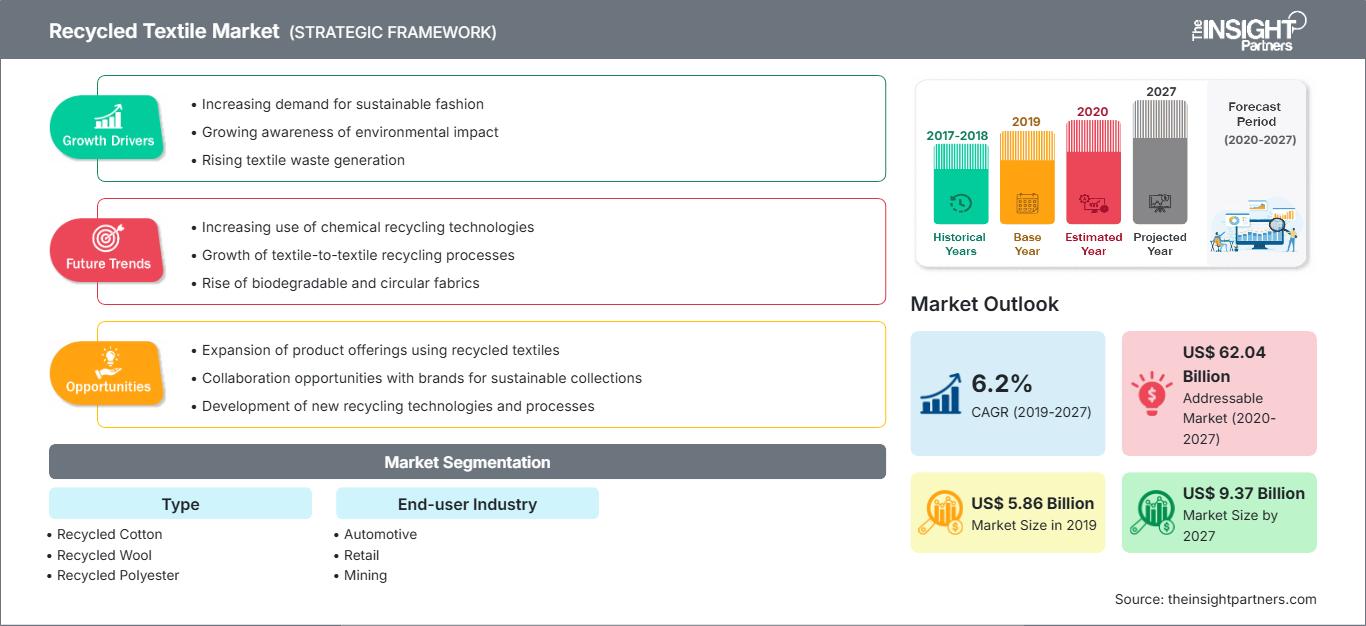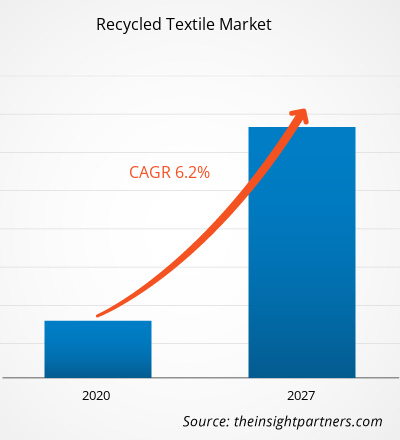The recycled textile market was valued at US$ 5,855.39 million in 2019 and is projected to reach US$ 9,365.04 million by 2027; it is expected to grow at a CAGR of 6.2% from 2020 to 2027.
Recycled textile is old clothing or other unused textile that can be recovered for reuse or material recovery. In recent years, there have been rising concerns related to the disposal of textile waste across the globe which may negatively impact the environment. The demand for recycled textile is rising across the globe with a surge in demand from several end use industries including garments, fabrics automotive and others. Manufacturers recycle the used textile into better product, which could be used across diversified end use industries, have adopted several technologies. The recycling of resources can mainly be done with the help of thermal, mechanical and chemical techniques.
Europe has become a significant Recycled Textile market for the recycled textile on account of rising government initiatives in the region. Moreover, the growing demand of recycled textile products among the automotive industry provides a lucrative opportunity for the recycled textile market players operating in the market. Increase in the purchasing power coupled with changing lifestyle is one of the major driving factors for textile market growth in Europe region. In Europe nearly 15% of consumer-used clothing is recycled, while more than 75% of pre-use clothing is recycled by the manufacturers for industrial uses. The demand for the recycled textile in the Europe is growing at a highest pace over the past few years. The recycled textile producers are focusing on countries such as Germany, United Kingdom etc. which has led to a huge demand for recycled textile in the Europe region. Rising consumer focus towards a circular textiles economy is also expected to boost the market growth in the region to a greater extent.
The US, Brazil, India, Russia, South Africa, Mexico, Spain, and the UK are among the most affected countries in terms of confirmed cases and reported deaths as of August 2020. COVID-19 has affected economies and industries in various countries due to lockdowns, travel bans, and business shutdowns. The global chemical and materials industry are one of the major industries suffering serious disruptions such as supply chain breaks, disruptions in manufacturing due to COVID-19 outbreak. For instance, China is the global hub of manufacturing and the largest raw material supplier for various industries. The lockdown of various plants and factories in China and leading regions such as Asia Pacific and Europe are affecting the global supply chains and negatively impacting the manufacturing, delivery schedules, and sales of various goods. All these factors have greatly affected the global recycled textile market.
Customize This Report To Suit Your Requirement
You will get customization on any report - free of charge - including parts of this report, or country-level analysis, Excel Data pack, as well as avail great offers and discounts for start-ups & universities
Recycled Textile Market: Strategic Insights

-
Get Top Key Market Trends of this report.This FREE sample will include data analysis, ranging from market trends to estimates and forecasts.
Market Insights
Rising Concerns Related to Disposal of Textile Waste
The textile manufacturing mechanism is considered to be one of the chemical intensive processes which generate a high volume of textile waste throughout its operations. The textile waste may be segregated into two groups, pre-consumer textile waste and post-consumer textile. The rise in amount of textile waste creates a burden on environment and generates the problem of effective disposal or incineration on existing landfills. According to an estimate, approximately 10–20% of all unused textile products are considered to be wasted. For instance, according to US EPA, in 2015, a total of 15.75 million tons of textiles were generated as municipal solid waste, of which 19% were incinerated, while 65 percent, ended in landfills. Further, a report by U.S. Environmental Protection Agency suggests that production and disposal of textiles results into greenhouse gas emissions. Further, the process of incineration emits organic substances such as heavy metals, dioxins, acidic gases and dust particles, which are considered as harmful to both humans and the environment. Also, the disposing of residual ash has also become a serious issue as it also contains a high concentration of toxic material. Hence, it is quite imperative to effectively manage of textile waste through reuse or recycling methods, which could promote environment sustainability. Under such situations, recycling of textile waste is considered to be a viable alternative, which helps to reduce burden on natural resource, minimizes the need for landfill space and helps in saving energy. Moreover, the stringent government legislations regulating the effective management of textile waste are potentially aimed to promote the use of textile recycling as a sustainable alternative to treat the impending problem related to waste.
Type Insights
Based on type, the recycled textile market is segmented into recycled cotton, recycled wool, recycled polyester, recycled nylon, and others. The recycled nylon segment is expected to grow at fastest growth rate during the forecast period of 2019-2027. Recycled nylon is made from industrial plastics, waste fibers, discards from weaving mills, and post-consumer fishing nets. They are regenerated into new nylon, which has the same quality as that of virgin nylon. Nylon bags, nylon fabrics, and nylon carpets are also converted into recycled nylon for further use. A large proportion of the recycled nylon comes from the fishing nets. It acts as a great solution to divert ocean garbage. Recycling nylon is an expensive process as compared to nylon, but it offers many environmental benefits. By recycling nylon, one can eliminate discards and reduce the amount of greenhouse gas emissions from manufacturing. It lessens the dependence on petroleum as a raw material source. Using recycled nylon also helps in promoting new recycling streams for nylon products that are no longer in use. Most mechanically recycled materials are melted at high temperatures that end up destroying contaminants and transform the materials into reusable forms. Nylon melts at low temperatures while recycling, leaving the contaminants behind. Therefore, nylon requires to be carefully cleaned before recycling.
End-User Industry Insights
Based on end-user industry, the recycled market is segmented into automotive, retail, mining and others. The automotive segment is expected to grow at fastest growth rate during the forecast period of 2019-2027. Recycled textiles used in the automotive industry and have a large contribution in the production of automobile components. The use of recycled textiles in automotive applications includes visible components like floor coverings, upholstery, safety belts, and not visible to viewers recycled textiles like tubes and tapes, tyre cord, airbags components, and fibers. Recycled textiles are used in automotive industry owing to their tensile strength, abrasion, air permeability, compression resistance, elasticity, ease of cleaning, flame resistance and resistance to dynamic climatic conditions. Recycled cotton is used in seat stuffing or automotive insulation.
Anandi Enterprises, Chindi, Khaloom Textile India Pvt. Ltd., Kishco Group, amongst others are the key players present in the global recycled textile market. These companies are implementing new product development and mergers and acquisition strategies to enlarge the customer base and gain significant market share across the world, which, in turn permit the players to maintain their brand name globally.
Recycled Textile Market Regional InsightsThe regional trends and factors influencing the Recycled Textile Market throughout the forecast period have been thoroughly explained by the analysts at The Insight Partners. This section also discusses Recycled Textile Market segments and geography across North America, Europe, Asia Pacific, Middle East and Africa, and South and Central America.
Recycled Textile Market Report Scope
| Report Attribute | Details |
|---|---|
| Market size in 2019 | US$ 5.86 Billion |
| Market Size by 2027 | US$ 9.37 Billion |
| Global CAGR (2019 - 2027) | 6.2% |
| Historical Data | 2017-2018 |
| Forecast period | 2020-2027 |
| Segments Covered |
By Type
|
| Regions and Countries Covered |
North America
|
| Market leaders and key company profiles |
|
Recycled Textile Market Players Density: Understanding Its Impact on Business Dynamics
The Recycled Textile Market is growing rapidly, driven by increasing end-user demand due to factors such as evolving consumer preferences, technological advancements, and greater awareness of the product's benefits. As demand rises, businesses are expanding their offerings, innovating to meet consumer needs, and capitalizing on emerging trends, which further fuels market growth.

- Get the Recycled Textile Market top key players overview
Report Spotlights
- Progressive industry trends in the global recycled textile market help players develop effective long-term strategies
- Business growth strategies adopted by developed and developing markets
- Quantitative analysis of the global recycled textile market from 2017 to 2027
- Estimation of global recycled textile demand across various industries
- PEST analysis to illustrate the efficacy of buyers and suppliers operating in the industry to predict market growth
- Recent developments to understand the competitive market scenario and global recycled textile demand
- Market trends and outlook coupled with factors driving and restraining the growth of the global recycled textile market
- Decision-making process by understanding strategies that underpin commercial interest with regard to global recycled textile market growth
- Global recycled textile market size at various nodes of market.
- Detailed overview and segmentation of the global recycled textile market, as well as its dynamics in the industry
- Global recycled textile market size in various regions with promising growth opportunities
Global Recycled Textile Market, by Type
- Recycled Cotton
- Recycled Wool
- Recycled Polyester
- Recycled Nylon
- Others
Global Recycled Textile Market, by End-User Industry
- Automotive
- Retail
- Mining
- Others
Company Profiles
- Anandi Enterprises
- Chindi
- Khaloom Textile India Pvt. Ltd.
- Kishco Group
- Usha Yarns Limited
- Hyosung Corporation
- Leigh Fibers Inc.
- Martex Fiber Southern Corporation
- Renewcell AB
- Boer Group
Frequently Asked Questions
Which driver is expected to boost the growth of recycled textile during the forecast period?
Which end user industry segment led the global recycled textile market in 2020?
Based on type, which segment emerged as the fastest growing segment in the global recycled textile market?
On the basis of type, why recycled polyester segment accounted for the largest share in the global recycled textile market?
Can you list some of the major players operating in the global recycled textile market?
During the forecast period, which region is anticipated to account for the largest share of the global recycled textile market?
- Historical Analysis (2 Years), Base Year, Forecast (7 Years) with CAGR
- PEST and SWOT Analysis
- Market Size Value / Volume - Global, Regional, Country
- Industry and Competitive Landscape
- Excel Dataset
Recent Reports
Testimonials
Reason to Buy
- Informed Decision-Making
- Understanding Market Dynamics
- Competitive Analysis
- Identifying Emerging Markets
- Customer Insights
- Market Forecasts
- Risk Mitigation
- Boosting Operational Efficiency
- Strategic Planning
- Investment Justification
- Tracking Industry Innovations
- Aligning with Regulatory Trends





















 Get Free Sample For
Get Free Sample For